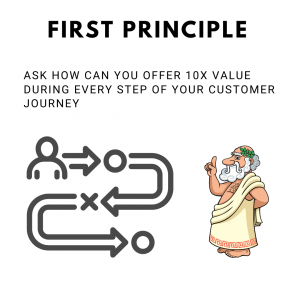Are you ready to take your business to new heights with the perfect software solution? In the digital realm, where competition is fierce and technology is ever-evolving, choosing the right path can be a daunting task. But fear not, for we have the ultimate guide to help you navigate the labyrinth of SaaS and Traditional Software options.
In this blog post, we unravel the mysteries behind these two powerhouses of the software world, arming you with the knowledge to make a game-changing decision. Whether you’re a startup entrepreneur seeking seamless scalability or an established enterprise craving data security, we’ve got you covered.
Say goodbye to confusion and embrace clarity as we delve into the key differentiators of SaaS and Traditional Software. So, buckle up and get ready to embark on this exhilarating journey of discovery to find the perfect software solution tailor-made for your unique business needs. Let’s dive in!

What is a Traditional Software?
History of Traditional Software
The evolution of software dates back to the early days of computing, where large mainframes hosted applications that were accessible through terminals. Over time, as technology progressed, businesses began adopting traditional software, which is installed locally on individual computers or servers. This model prevailed for decades and continues to be in use, though newer alternatives like SaaS have emerged.
How Traditional Software Works?
Traditional software operates on a client-server architecture. The software is installed on the client’s premises, allowing users to access and run applications from their devices. This on-premise hosting grants companies greater control over their data and security, but it also entails higher initial costs and maintenance responsibilities.
What is SaaS?
Understanding SaaS
SaaS, on the other hand, is a cloud-based software model that has gained immense popularity in recent years. It eliminates the need for local installation and instead provides access to applications via the Internet. SaaS offerings are managed and maintained by the provider, freeing businesses from the burden of software maintenance.

How Does SaaS Work?
SaaS operates on a multi-tenant architecture, where a single instance of the software serves multiple customers. Users can access the software through web browsers, and the data is securely stored in the cloud. This cloud-based approach offers flexibility, scalability, and automatic updates, making it an attractive choice for businesses of all sizes.
Decoding the Traditional Software Model
Your Private Sanctuary: On-Premise Hosting in Traditional Software
Traditional software grants companies complete control over their data and infrastructure, as it is hosted locally on their servers. This level of privacy can be crucial for businesses that handle sensitive information or operate in regulated industries.
License to Use: Understanding Software Licensing
With traditional software, businesses typically purchase licenses for specific numbers of users or installations. These licenses can be perpetual or time-bound, depending on the software vendor’s terms. Although the upfront cost can be significant, some businesses find this approach financially viable in the long run.
The Maintenance Chronicle: Upkeeping Traditional Software
Maintaining traditional software involves handling updates, patches, and bug fixes independently. While this level of control might suit some organizations, it can also require dedicated IT staff and consume valuable time and resources.
Exploring the SaaS Model
Living on the Cloud: Hosting in SaaS
SaaS offers a cloud-based environment where the software and data are stored securely on the provider’s servers. This eliminates the need for on-premise infrastructure, saving costs and reducing IT complexity.
Pay as You Go: The SaaS Subscription Model
Unlike traditional software, which involves a substantial upfront investment, SaaS operates on a subscription-based model. Businesses pay a periodic fee based on their usage, making it a more cost-effective option, especially for smaller companies with budget constraints.
Update Me Not: Automated Maintenance in SaaS
SaaS providers take care of all maintenance, including updates, security patches, and backups. This hands-off approach allows businesses to focus on their core operations without worrying about software upkeep.

Advantages of Traditional Software
The Control Tower: High Customization Potential
Traditional software allows for extensive customization to meet the unique needs of businesses. Companies can tailor the software according to their specific requirements, giving them a competitive edge in their respective industries.
Your Fortress: Enhanced Security Control
Since traditional software is hosted on-premise, businesses have direct control over their data security. They can implement and monitor security protocols that align with their internal policies and regulatory compliance.
No Strings Attached: Independent of Internet Connection
Traditional software operates locally, making it independent of internet connectivity. This aspect is advantageous for businesses in remote locations or areas with unreliable internet access.
Advantages of SaaS
Quick off the Blocks: Rapid Deployment
SaaS solutions can be deployed swiftly, as there’s no need for lengthy installation processes. Users can access the software almost instantly through the internet, leading to faster implementation and productivity gains.
The Pocket-Friendly Marvel: Cost-Effectiveness
With no substantial upfront costs, SaaS is an attractive option for businesses with limited budgets. The subscription-based model allows them to pay only for the services they use, optimizing cost-effectiveness.
Global Passport: Accessibility from Anywhere
SaaS offers unparalleled flexibility, allowing users to access applications from any device with an internet connection. This global accessibility empowers businesses with distributed teams and international operations.

Never Outdated: Automatic Updates
SaaS providers regularly update their software to ensure it remains secure and up-to-date with the latest features. This continuous improvement benefits businesses by keeping them on the cutting edge without any additional effort.
Challenges with Traditional Software
Weight of the Wallet: High Initial Costs
One of the most significant challenges with traditional software is the substantial upfront investment required to purchase licenses and infrastructure.
The Time Vortex: Long Implementation Process
Traditional software often involves time-consuming installation and configuration processes, delaying its deployment and potential benefits.
DIY Trouble: Self-handled Maintenance and Upgrades
Maintaining traditional software demands internal IT expertise and resources, which can be a burden for smaller businesses without dedicated IT departments.
Challenges with SaaS
The Tug of War: Lesser Customization
SaaS, being a shared multi-tenant environment, might have limited customization options compared to traditional software tailored to a specific organization.
Internet – A Friend or Foe: Dependence on Internet Connection
Since SaaS relies on internet connectivity, any disruptions or downtime can hinder users’ ability to access critical applications.
Keeping Secrets: Data Security Concerns
SaaS involves entrusting sensitive data to third-party providers, raising security concerns for businesses operating in highly regulated industries or with strict data protection policies.

The Great Debate: SaaS or Traditional Software for Various Business Aspects
Budget Showdown: SaaS vs. Traditional Software
When it comes to budget considerations, SaaS often emerges as the more cost-effective choice due to its subscription-based pricing model.
The Race of Implementation: SaaS vs. Traditional Software
For businesses seeking quick deployment and accessibility, SaaS takes the lead with its faster implementation process.
Battle of Upgrades: SaaS vs. Traditional Software
SaaS’s automatic updates eliminate the need for manual software upgrades, offering a clear advantage over traditional software in this aspect.
The Customization Conundrum: SaaS vs. Traditional Software
Businesses requiring high levels of customization may lean towards traditional software, where tailor-made solutions are more feasible.
The Fight for Flexibility: SaaS vs. Traditional Software
SaaS wins the flexibility battle with its cloud-based accessibility, enabling users to work from anywhere with an internet connection.
The Security Standoff: SaaS vs. Traditional Software
While traditional software offers enhanced control over data security, SaaS providers invest heavily in top-notch security measures to counter potential threats.

Deciding What’s Best for Your Business
Size Matters: SaaS or Traditional Software for Small, Medium, and Large Businesses
When it comes to the size of your business, the choice between SaaS and traditional software can have significant implications. Small businesses often have limited resources, making SaaS an appealing option due to its lower upfront costs and pay-as-you-go subscription model. SaaS allows small businesses to access sophisticated software without making a substantial financial commitment, which is crucial for those starting their journey or facing budget constraints.
Medium-sized enterprises may have a bit more flexibility in their choices. Some may lean towards traditional software if they prioritize extensive customization to match their specific needs, or if they require complete control over their data and infrastructure. On the other hand, medium-sized businesses looking for rapid deployment and scalability might find SaaS more suitable.
Large businesses have the advantage of having more resources at their disposal, and they often prioritize security, control, and customization. Thus, traditional software might be a preferred choice for large enterprises. However, with the growing trend of cloud adoption and the need for agile operations, some large corporations are embracing SaaS for specific applications or departments, while retaining traditional software for other critical functions.

Which is Preferred by the Industries?
Different industries have diverse requirements and regulations, influencing their preferences for software models. For instance, industries dealing with sensitive information, such as finance and healthcare, may prefer the control and security offered by traditional software hosted on-premise. They often have strict data privacy and compliance requirements that demand a higher level of customization and data management.
However, industries characterized by distributed teams, remote work, and the need for seamless collaboration often gravitate toward SaaS solutions. SaaS allows employees to access the software from anywhere with an internet connection, empowering organizations with greater mobility and flexibility. Industries like technology startups, creative agencies, and consulting firms find SaaS particularly beneficial due to its ease of deployment and scalability.
Future-Proofing Your Business: Considering the Long-Term Perspective
When it comes to making technology decisions for your business, it is crucial to consider the long-term perspective. Technology is constantly evolving, and the software you choose should align with your organization’s future goals and growth plans.
Traditional software, while robust and customizable, might come with limitations when it comes to future scalability and adaptability. As your business expands, the cost and effort required to maintain and upgrade traditional software may become burdensome. Additionally, with rapid advancements in technology, traditional software might struggle to keep up with the latest features and innovations.
On the other hand, SaaS is designed with scalability in mind. Cloud-based solutions can easily accommodate the growing needs of your business, and SaaS providers continuously update their offerings with the latest features. This future-proofing aspect makes SaaS an attractive choice for businesses looking to stay competitive and agile in the dynamic market.
Expert Opinions on SaaS vs. Traditional Software
We reached out to industry experts and professionals in various fields to gather their insights and opinions on the SaaS vs. traditional software debate. The consensus among experts is that there is no one-size-fits-all answer. Instead, the decision depends on the specific needs and priorities of each business.
Some experts highlighted the importance of carefully assessing the security and compliance requirements of the business when making this choice. For highly regulated industries, traditional software might be the preferred option to maintain strict control over data and meet industry-specific compliance standards.
Others emphasized the benefits of SaaS, especially for startups and small businesses, as it enables them to access enterprise-grade software without incurring significant upfront costs. SaaS also allows businesses to scale up or down easily as their needs change, making it an agile and cost-effective solution.
Additionally, several experts emphasized the potential benefits of hybrid solutions, where businesses integrate both SaaS and traditional software to leverage the advantages of both models. This approach allows businesses to tailor their software strategy to different departments or operations, optimizing cost, and performance.

Case Studies
Real Stories: Businesses that Flourished with Traditional Software
Now, let’s delve into some real-life examples of businesses that have thrived by choosing traditional software solutions. These case studies will shed light on how organizations from diverse industries have utilized traditional software to their advantage.
Financial Institution A – Empowering Data Security and Compliance
Financial Institution A, a large banking institution, deals with vast amounts of sensitive customer data daily. To ensure strict compliance with data protection regulations, they opted for traditional software solutions hosted on their own servers. This approach allows the institution to maintain complete control over its data and implement robust security measures tailored to its specific requirements.
Manufacturing Company B – Streamlining Operations with Customization
Manufacturing Company B faced unique operational challenges and required software tailored to their specific production processes. They chose traditional software that could be extensively customized to optimize their workflow. This level of customization allowed them to streamline their operations and boost productivity significantly.
Success Stories of SaaS Implementation
On the other side of the spectrum, let’s explore some success stories of businesses that have embraced SaaS solutions and reaped the benefits of cloud-based software models.
Start-up C – Rapid Scaling and Cost-Effectiveness
Start-up C, a technology start-up with a small team, needed a solution that would enable them to scale quickly without incurring massive upfront costs. They opted for SaaS solutions for their CRM, project management, and communication needs. This choice allowed them to rapidly deploy essential software tools, focus on their core business activities, and remain within their budget constraints.
Marketing Agency D – Seamless Collaboration and Flexibility
Marketing Agency D operates with a distributed team across different time zones. To ensure seamless collaboration and flexibility, they adopted SaaS tools for their project management, creative collaboration, and reporting needs. With these cloud-based solutions, team members can work from anywhere, fostering a culture of remote work and maximizing productivity.

Conclusion
After exploring the intricacies of both SaaS and traditional software models, it becomes evident that there is no definitive winner in the SaaS vs. traditional software debate. Each model offers its unique advantages and challenges, and the best choice for your business depends on your organization’s specific needs, size, industry, and long-term goals.
When making this critical decision, it is essential to conduct a thorough assessment of your business requirements, budget constraints, and growth plans. Both SaaS and traditional software have proven to be valuable solutions for various businesses, and in many cases, a hybrid approach integrating both models might be the most effective strategy.



